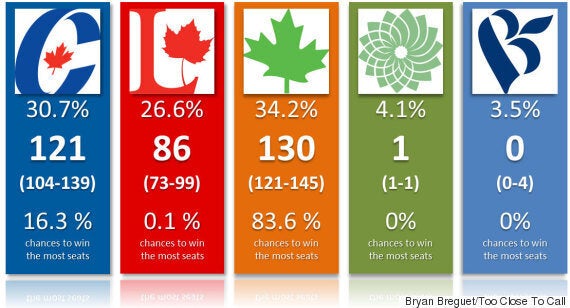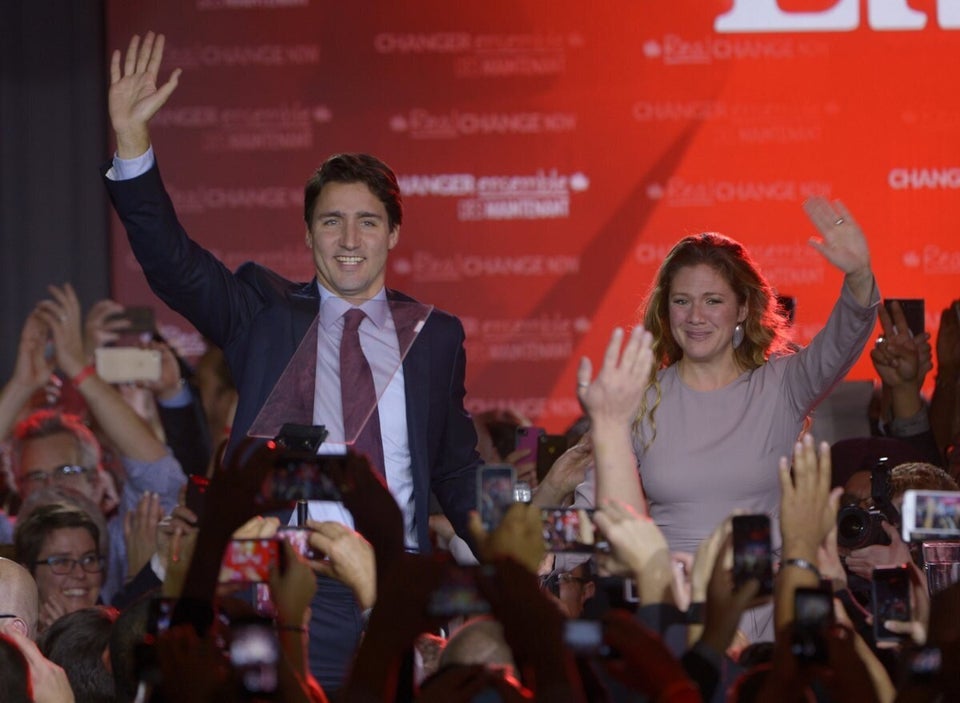While the latest numbers mostly paint a stable situation, there is slightly more noise in the data with some polls not actually agreeing whether the Liberals are second or third.
Once we average the polls, however, we see that Justin Trudeau’s chances of becoming prime minister haven’t actually improved and that the NDP remains the clear favourite.
The NDP had the lead in each of the past seven full national polls (except in the rolling average of Nanos, where the Tories are slightly ahead), but the numbers get interesting with a little closer look.
The latest Ipsos poll, for instance, shows Thomas Mulcair’s party only four percentage points ahead of the Conservatives, while the latest Forum numbers show them with a 17-point lead (40 percent vs 23 percent). At the same time, the Liberals were third in five polls and second in two (Ipsos and Forum).
The current consensus based on the polls is that the New Democrats are in the lead while the Tories and Grits are fighting for second place.
There is nevertheless a considerable amount of inconsistency noise in the data. And we aren’t talking only of the national level. If you go to the provincial level, you can find even bigger variations (which is expected, given the sample sizes).
Before turning these numbers into seat projections, let’s discuss the possibility that the Liberals actually are in second place. As mentioned above, only two polls have this situation, and one of them (the Forum) has numbers so far from the average that the firm is either picking up something nobody else is, or its poll was a clear outlier.
More generally, let’s not forget the margins of error. Depending on the sample size, they range from one to three percentage points. With all three parties so close, we should actually expect the natural sampling variations to generate some volatility in the order of the main three parties.
In other words, it is not weird or wrong (or even unexpected) to have the Liberals second in some polls. What matters is the average, and so far, we haven’t seen any major change since the campaign began.
We see a slight upward trend for the Liberals and a small decrease for the Conservatives. Does it mean the battle has moved from NDP versus Tories for first to Conservatives versus Liberals for second? That is definitely not the case right now.
The most up-to-date projections are below. They use past election results as well as the current polls to predict the winner in the 338 ridings. They include regional and incumbency effects. The confidence intervals and the chances of winning are obtained through the use of 5,000 simulations that account for the uncertainty of the polls as well as for the distribution of the vote and the electoral system. In other words, these simulations try to include every possible scenario, given the information we currently have.
Projections as of Aug. 29:

You can find the detailed riding by riding projections here.
Overall, the situation hasn’t changed dramatically (if at all) from last week. We still have the NDP ahead and the favourite with the Conservatives fighting to stay in power.
The Liberals are stable. Let’s remember that only two out of seven polls showed them in second place. And the electoral system isn’t really working in their favour right now.
If there is a small upward trend for the Liberals, its effects are attenuated or cancelled by the small upward trend for the NDP as well. The net result is actually relatively stable chances of winning for all three parties. For the Liberals, in particular, chances are still well below one per cent, and we are a long way from having another Trudeau as prime minister.
The stability extends to the provinces. Quebec is still all but certain to provide the NDP with easily more than 50 seats, Ontario continues to be split almost three equal ways. Alberta is remaining blue, so don’t expect major NDP gains there. At best, Thomas Mulcair could expect some victories in Edmonton.
The Atlantic appears to have become slightly more competitive, which isn’t good news for Trudeau, as that was the only region where he has been likely to win the majority of seats. Remember that as far as winning the most seats overall, having one region where you dominate completely is of tremendous help. The New Democrats have Quebec (and possibly B.C.), the Conservatives have Alberta and, to a lesser extent, the Prairies.
Out of our 5,000 simulations, there is only one in which the NDP is projected to win a majority. While such an extreme scenario is interesting, we shouldn’t be mistaken: no party is currently in a position where a majority is realistically reachable. The New Democrats are the closest, but they would need to go up slightly. (Of course, if Forum was right, then Mulcair could easily win more than 169 seats).
According to the latest Angus-Reid, a NDP minority is the preferred outcome of only 11 per cent of the voters. On the other hand, 12 per cent would like a Conservative minority, 24 per cent a Conservative majority, 25 per cent an NDP majority and 29 per cent an NDP-Liberal coalition.
The current most likely outcome is, therefore, the least favourite for the voters. Beyond the obvious paradox, it seems clear voters would prefer to avoid the potential instability of another minority. If this continues to be the case, one may wonder if some NDP-LPC voters won’t switch between now and Oct. 19 to the party more likely to win a majority.
At this little game, the NDP is clearly favoured right now. Plus, the numbers usually show that more Liberals have the NDP as second choice than NDP have Liberals. For instance, Innovative shows that while 52 percent of Liberals voters have the NDP as second choice, “only” 45 percent of NDP would choose the Liberals. This pattern is similar to other polls. It thus seems that it would be slightly easier to have a LPC-to-NDP switch than the opposite.
Finally, there are currently 102 ridings where the winner is projected with near-100 per cent certainty. The model has never made a mistake making a call with that level of confidence. Out of these 102 electoral districts, 52 back the NDP (mostly in Quebec), 37 the CPC and only 12 for the Liberals. Elizabeth May for the Green Party is the last one. There again, we see the edge the NDP has, especially over the Liberals.
Don’t be fooled by the natural sampling or statistical variations of the polls. If we take an average, we see a relatively stable situation in which the NDP is the clear favourite.
If we have to find trends, at this point of the campaign, it’d have to be a small decrease for Stephen Harper and his party and small increases for the Liberals. But it hasn’t caused major gains in terms of seats for the Liberals (yet?).
It also doesn’t mean Harper shouldn’t be worried, as this campaign hasn’t been very kind to him so far, and a decrease is a move in the wrong direction.
ALSO ON HUFFPOST:
Information about the new polls mentioned in this article:
1. Forum poll conducted Aug. 23 and 24. 1,440 respondents contacted by phone (IVR). Margins of error are three percentage points 19 times out of 20. Question asked: “A federal election has been called for October 19. Which party are you most likely to vote for in this election?”
2. Ipsos poll conducted between Aug. 24 and 26. 1,000 respondents from the Ipsos online panel. A probabilistic sample of this size has margins of error of three percentage points 19 times out of 20. Question asked: “Thinking of how you feel right now, if a federal election were held tomorrow, which of the following parties' candidates would you, yourself, be more likely to support?”
3. Angus-Reid poll conducted between Aug. 19 and 24. 6,226 respondents from the Angus-Reid online panel. A probabilistic sample of this size has margins of error of 1.2 percentage points 19 times out of 20. Question asked: “If a federal election were held tomorrow, which one of the following parties would you be most likely to support in your constituency?”
4. Innovative poll conducted between Aug. 24 and 26. 3,274 respondents from the Innovative national online panel. A probabilistic sample of this size has margins of error of 1.7 percentage points 19 times out of 20. Question asked: “If a federal election were held today, which party would you vote for?”
Bryan Breguet has a B.Sc in economics of politics and a M.sc in economics from the University of Montreal. He founded TooCloseToCall.ca in 2010 where he provides electoral analysis and projections. He has collaborated with the National Post, Journal de Montreal and l’Actualité.
He will provide analysis and updates for The Huffington Post Canada throughout the federal election campaign. For riding by riding projections, visit his interactive simulator.

